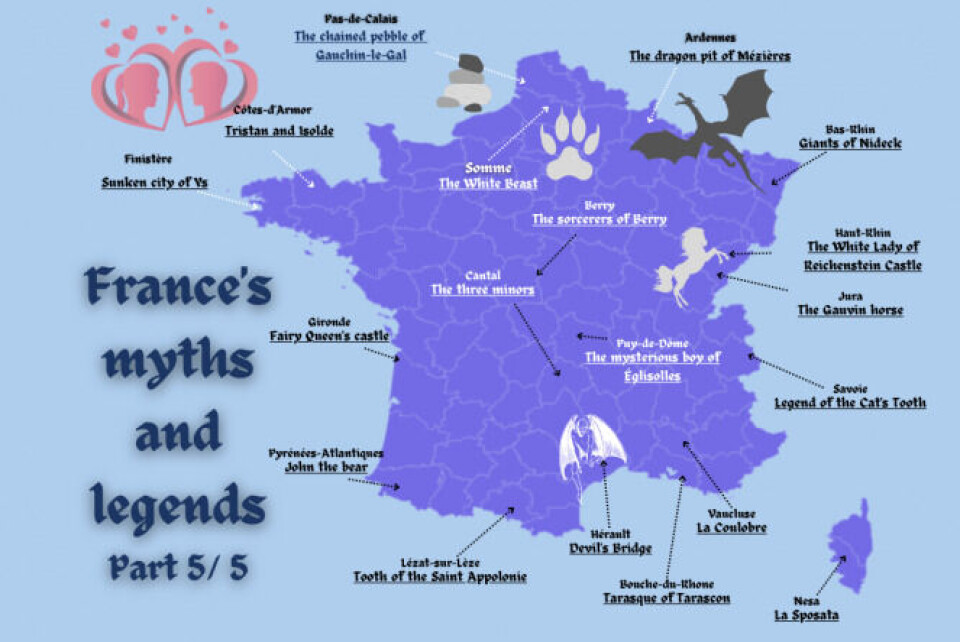-
Grand crème, café crème, au lait: how to order coffee in France?
We explain the subtle distinctions between the various terms used in cafés
-
Know your cheeses and their seasons: which to eat in France in February
Cow’s milk cheeses dominate as winter comes to an end
-
Films and series to watch in February to improve your French
Every month we outline good film and TV series to improve your language
French legends part five: Kings and magic – stories from the centre
We end our myths and legends’ series with a look at the middle of France from a mysterious boy, to three unfortunate miners and a land of sorcerers

This is the final part of a five-part series.
You can read part one of the series here: French legends part 1: Beasts and beauty - stories from the north
Part two of the series here: French legends part two: Giants and ghosts – stories from the east
Part three of the series here: French legends part three: Devils & dentists – stories from the south
And part four of the series here: French legends part four: Bluebeard and bears – stories from the west

The mysterious boy of Églisolles
This may not be a supernatural legend but it is certainly a rumour of a legendary nature.
The year is 1795 and on June 8, the young King Louis XVII supposedly dies at the age of 10 of tuberculosis.
His death comes at a tumultuous time for French royalty, it being just six years after the beginning of the French Revolution and two years after the decapitations of Louis XVII’s parents, King Louis XVI and Marie Antoinette.
But a rumour spreads around the courts that perhaps the young king is not dead but has simply fled.
At the same time, villagers in Églisolles (Puy-de-Dôme) notice that a young boy around the age of 10 has suddenly appeared at the house of a family of farmers with the surname Chomette.
One day they had eight children, the next day nine. And this young, blonde-haired boy they were calling Blaise had a certain resemblance to Louis XVII.
The rumours are rife, but evidence is in short supply.
In the years that follow the appearance of Blaise, the family’s wealth appears to increase and they are able to buy a 40-hectare plot of land.
Where did the previously poor family get the money? No one knows. Was Blaise really Louis XVII in disguise? It seems that the mystery has been lost to history.
The three miners
The three miners is a religious fable from the department of Cantal.
The story goes that every day, three hard-working, Christian miners do a small prayer before descending into the antimony mines around the village of Massiac.
But one day, whether they were in a rush or just not concentrating, they forgot to do their prayer.
They descended into the mine and suddenly a landslide hit and buried them alive down the hole.
Stuck in the darkness, they began to pray.
At that moment, a genie appears to them. It touched the small piece of bread they had with them with its finger and poured oil into their lamp. Then it disappeared.
The miners quickly discovered that no matter how much of the bread they ate, the piece they had never got smaller, and no matter how long the lamp remained lit, it never went out.
Seven years the miners remained stuck in the mine.
One day, they again turned to God.
The first miner prayed hard and said: “If one day I am able to just see the sunlight again, I will die happy.”
The second miner, also praying, said, “And me, I would be happy to see my children and wife again and to sit around the table with them, even if it was only for a moment”.
The third miner said, “What I desire most of all is to return to the world of the living and to just spend one year with my family”.
As soon as the third miner finished his prayer, the pile of earth and rocks that blocked the exit suddenly disappeared and the three miners could finally leave their prison.
The first man took a single breath outside, glanced into the sunlight and immediately died.
The second man returned to his family. At first they did not recognise them but as soon as he shaved his beard and cut his hair, they all embraced him. They sat down to eat dinner together and as soon as the miner took the final bite of bread and the final sip of wine, he too died.
The third miner was able to return home and, as he had wished, he spent a full year with his family. The very second after the year was over, he fell down and died.
It is unclear exactly what the moral of this story is – perhaps it is to not anger God, or perhaps it is that if you are going to make a wish, you might as well make it an ambitious one.
The sorcerers of Berry
This is not one, single story but rather the reputation that the region of Berry has for being a place of sorcery, magic and ghouls.
Berry is a former province located in central France and now consists of the departments of Cher, Indre and parts of Creuse.
It has long been associated with the supernatural.
Even to this day, there are many in the area who believe in the dark arts.
It is likely that the reputation of this region as a place of magic was in part thanks to the French author George Sand, who wrote about Berry and some of the dark customs of the region. This is also true in her popular novel called the ‘La Mare au diable’ (the devil's pool), published in 1846.
Whether you believe in that type of thing or not, Berry certainly has some spooky sites, like the Bois de Chanteloube.
The above map and article is also part of our ongoing series showcasing different elements of French society and culture.
We have also written about French inventors, cheeses, funny commune names, local sweets and desserts, local aperitifs and many other topics.
If you have any suggestions for maps you would like us to make or think we should add anything to our previous articles, let us know at news@connexionfrance.com.
Related articles
Five French stories that mix history and myth - from Caesar to Clovis
Urban myth or true: Is it illegal to call a pig Napoleon in France?
Truth or myth?: Napoleon and the story of the truncated pyramid cheese
























